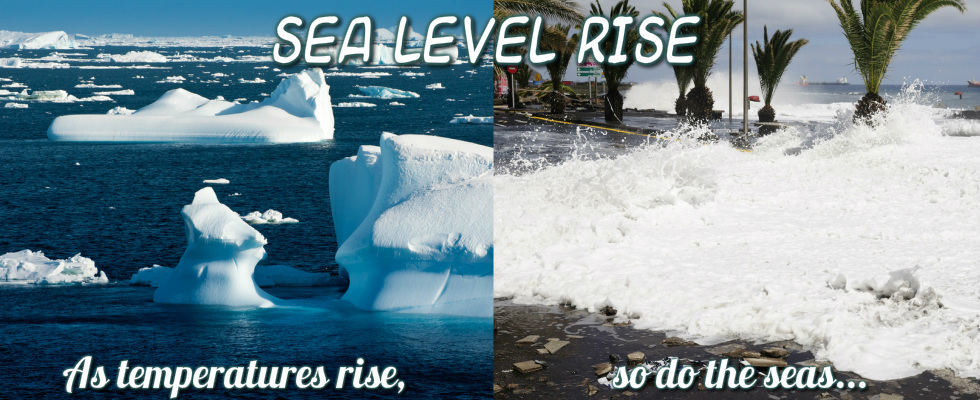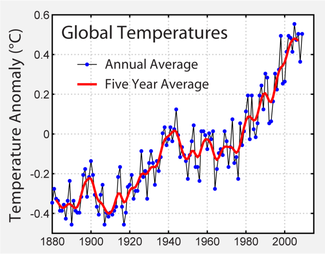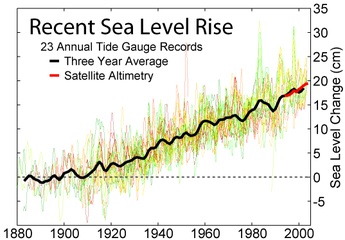
Sea Level Rise
As the
planet continues to warm and ice sheets continue to melt, sea levels are rising worldwide at ever-increasing rates. The two major causes of global sea level rise are
thermal expansion of the oceans, which occurs when water expands as it warms, and the
loss of land and sea-based ice, such as polar ice caps and glaciers, due to increased melting at the hands of
global warming. Global sea levels rose about
17 centimeters (6.7 inches) in the last century. The rate in the last decade, however, is
nearly double that of the last century
and
NASA scientists are predicting
it could be as much as several meters sea level rise this century, if
global warming
is not
addressed. With
70% of the world's population living on low-lying coastal plains
and with
60% of the 39 largest metropolitan areas with a population over 5 million, including 12 of the 16 with populations exceeding 10 million, located within 100km of the coast, sea level rise is a global problem that affects far more than just small island nations. Sea levels, which are now
rising 60% faster than previously estimated up until 2011, could rise
6 feet by 2100, 18-29 feet above current levels over the next few centuries
and
69-200 feet in the next, at least, 1000-2000 years, if we continue our current carbon emissions path. Even if we were to stabilize global average temperatures at
2°C (3.6F), equivalent to 350ppm, which is what scientists say is the upper safe limit for a stable climate, the warming would lead to
2.5 feet of sea level rise by 2100 and 8 feet by 2300. At a stabilization of 3°C, the warming would lead to
3 feet of sea level rise by 2100 and over 11 feet by 2300. The
2011 World Energy Outlook by the International Energy Agency
states that global temperatures could rise 6°C (11°F) by the end of the century at current rates of carbon emissions. As global temperatures rise, so will sea levels - unless
we act.
If current warming trends are allowed to continue, London, Bangkok, New York, Shanghai and Mumbai will be among a number of cities which will eventually end up below sea level displacing millions and causing massive economic damage. Learn more.
"Surging Seas" projects a 4 foot rise in sea levels during storms across the globe in the next 20 years. In New York, the chances of a 100-year flood or worse by 2030 have more than tripled, from 8% to 26%, thanks to global warming. NYC counts over 141,000 of its citizens living within three feet of high tide.
The West Antarctic Ice Sheet has increased 4.3 degrees Fahrenheit (2.4 degrees Celsius) in average annual temperature since 1958, which is three times faster than the average temperature rise around the globe. The West Antarctic Ice Sheet sits largely in the warming ocean, making it vulnerable to melting both due to rising air and water temperatures and contains enough trapped ice to raise sea levels up to 6 meters - almost 20 feet. Image: Debra Tillinger, NOAA/CC BY 2.0 | Click for source
"If present trends continue, including an increase in global temperatures caused by increased greenhouse-gas emissions, many of the world’s mountain glaciers will disappear. For example, at the current rate of melting, most glaciers will be gone from Glacier National Park, Montana, by the middle of the next century. In Iceland, about 11 percent of the island is covered by glaciers (mostly ice caps). If warming continues, Iceland’s glaciers will decrease by 40 percent by 2100 and virtually disappear by 2200. Most of the current global land ice mass is located in the Antarctic and Greenland ice sheets. Complete melting of these ice sheets could lead to a sea-level rise of about 80 meters, whereas melting of all other glaciers could lead to a sea-level rise of only one-half meter." ~ U.S. Geological Survey, Sea Level and Climate
"Rising seas dramatically increase the odds of damaging floods from storm surges. A Climate Central analysis
finds the odds of “century” or worse floods occurring by 2030 are on track to double or more, over widespread areas of the U.S. These increases threaten an enormous amount of damage. Across the country, nearly 5 million people live in 2.6 million homes at less than 4 feet above high tide — a level lower than the century flood line for most locations analyzed. And compounding this risk, scientists expect roughly 2 to 7 more feet of sea level rise this century — a lot depending upon how much more heat-trapping pollution humanity puts into the sky." ~ Climate Central: Surging Seas








